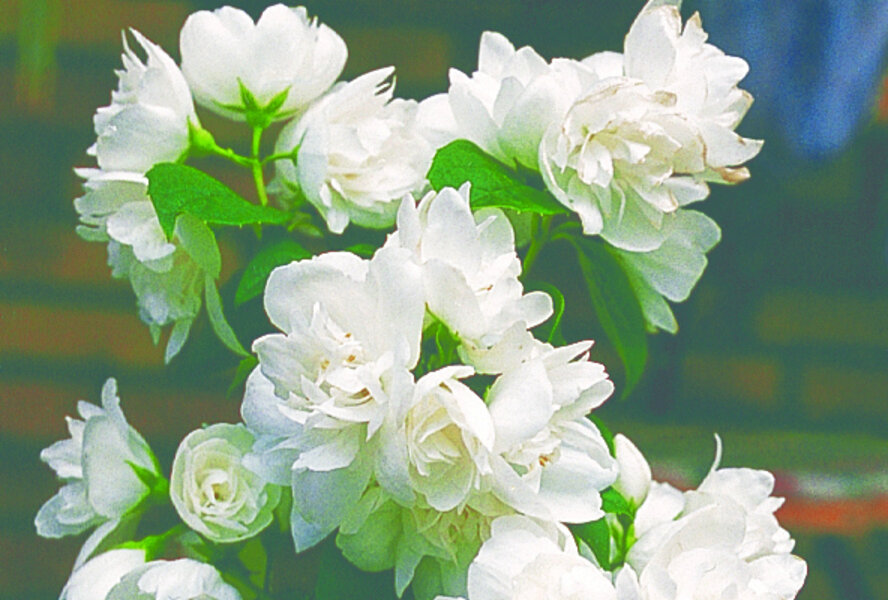A new mock orange reblooms
Loading...
One of the truly outstanding late-spring or early-summer flowering deciduous shrubs is mock orange, Philadelphus virginalis. Of the many species available to gardeners, this is probably the most popular, due in no small part, I’m sure, to its very pleasing fragrance and attractive white flowers.
An ancient group of shrubs named by Linnaeus in honor of King Ptolemy Philadelphus, who lived way back in 300 BC, and first introduced to Europe along with lilacs in 1562, these classic and easy-to-grow Victorian-era darlings are making a dramatic comeback these days.
Big time!
A reblooming cultivar
I’m a fickle gardener, I admit. Usually I’m passionately in love with whatever perennial or annual I’m looking at, at that moment. And though shrubs are also favorites, it’s been a long, long time since I’ve been excited about a new shrub introduction to the point of drooling.
But here I am salivating over a mock orange!
If you remember seeing mock orange shrubs in your grandmother’s garden, you know they were rangy plants that had no decorative value once they stopped blooming – so you might conclude that I’ve lost my horticultural mind!
But hear me out. The object of my current obsession is a newer introduction, a shrub officially known as Snow White Sensation (sometimes sold as Snow White Fantasy). Now I grow several older cultivars of mock orange for their scent, if not their beauty. However, Snow White Sensation (Snow White Fantasy) has knocked my garden clogs right out of the yard.
This is a beautiful, fast-growing shrub with gracefully arching branches. However, what makes her sensational are her two-inch, double snow-white flowers offered up in abundant clusters and smelling – well – like heaven.
And if she needed to strut her virtues even more, she sweetens the deal by blooming a second time!
The first flush occurs in late spring and then, come late summer, she does it again. Add attractive dark green foliage that stands up to our summer heat and drought tolerance once established, and is hardy to USDA Zone 4, this five-foot tall beauty gives the landscape three-season interest.
The reliable and durable mock orange
The majority of the shrubs – there are 65 species and countless hybrids – are large.eight- to 10-foot plants, which, when in bloom, perfume entire sections of the garden. The flowers are usually white, cup or bowl shaped, and can be either single, semidouble, or double.
Typically, the leaves are mid- to dark green in color; however, P. coronaries is the exception. Three noteworthy cultivars of it have different foliage: ‘Aureus’ and ‘Yellow Cab’ have golden yellow leaves, while ‘Variegatus’ sports cream-edged ones.
They like full sun, although they tolerate light shade and well-drained soil. As a bonus, mock orange has no serious pest or disease problems, though there is a bit of susceptibility to aphids and leaf miners, which is more of a nuisance than a threat.
Mock orange blooms on the previous year’s growth; therefore, prune immediately after it blooms. When it starts to look a bit overgrown and rangy, prune the oldest one-third of the branches down to ground level; following the same regime for the next two years. After three years, the shrub should, once again, be gorgeous.
One way to compensate for mock orange’s short bloom time and duller foliage – and an excellent way to bring color into the garden, if not to fool unsuspecting friends – is to train a small-flowered, long-blooming clematis vine to scramble through its branches.
Obviously, Snow White Sensation is not the only new girl in the garden in the world of mock orange. There are many others.
Some recent introductions have larger blossoms, others are shorter in size or more compact, making them perfect choices for small gardens, large containers, or planting at the front of the border.
Also, many of the newer introductions are fast growing and form a dense mound of gently cascading branches. They are also more heat-, cold-, and drought-tolerant.
One caveat
Fragrance is, as you can imagine, the major selling point for purchasing a mock orange shrub. Unfortunately, not all cultivars are equally fragrant. Thus, one of the best times to buy mock orange is when it’s in bloom at the nursery – that way you can let your nose do the choosing.
-----
Betty Earl, the Intrepid Gardener, is one of more than a dozen gardening experts from various parts of the country who blog regularly at Diggin' It. Her latest book is 'Fairy Gardens: A Guide to Growing an Enchanted Miniature World.' She writes a regular column for Chicagoland Gardening Magazine and The Kankakee Journal and numerous articles for Small Gardens Magazine, American Nurseryman, Nature’s Garden, and Midwest Living Magazine, as well as other national magazines. She is a garden scout for Better Homes and Gardens and a regional representative for The Garden Conservancy. To read more by Betty here at Diggin' It, click here.





